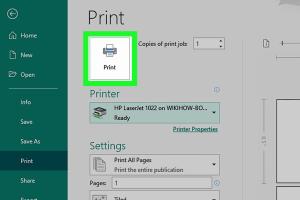Mastering the Art of Printing Mirror Images: A Comprehensive Guide

-
Quick Links:
- Introduction
- What is Mirror Image Printing?
- Applications of Mirror Image Printing
- Types of Printers Suitable for Mirror Image Printing
- Step-by-Step Guide to Printing Mirror Images
- Common Issues and Troubleshooting
- Case Studies
- Expert Insights
- FAQs
Introduction
Printing mirror images is a technique that many crafters and professionals utilize for various applications, from DIY projects to professional signage. Whether you're looking to create custom t-shirts, decals, or intricate art pieces, understanding how to print mirror images can open up a world of creative possibilities. In this guide, we’ll delve into the methods, applications, and best practices for printing mirror images.
What is Mirror Image Printing?
Mirror image printing refers to the process of creating a reversed version of a design or text, which appears as a mirror reflection. This technique is particularly useful when transferring designs onto surfaces where the printed side will not be visible, such as in the case of iron-on transfers.
Why Use Mirror Image Printing?
- Creative Flexibility: Allows for unique designs that can be applied to various mediums.
- Professional Quality: Creates polished and professional-looking products.
- Cost-Effective: Ideal for small businesses or DIY enthusiasts looking to save on printing costs.
Applications of Mirror Image Printing
Mirror image printing has a wide range of applications, including:
- Craft Projects: Ideal for creating personalized gifts and decorations.
- Signage: Used in creating high-quality signs for businesses.
- Apparel: Commonly used for t-shirt designs and other clothing items.
- Home Décor: Perfect for creating artwork or decorative items.
Types of Printers Suitable for Mirror Image Printing
Not all printers are suitable for mirror image printing. Here are some of the best options:
- Inkjet Printers: Widely available and versatile for most printing tasks.
- Laser Printers: Great for high-quality prints and often used in professional settings.
- Sublimation Printers: Best for fabrics and can produce vibrant colors.
Step-by-Step Guide to Printing Mirror Images
Follow these steps for successful mirror image printing:
Step 1: Choose Your Design
Select the image or text you want to print. Ensure it’s saved in a high-resolution format.
Step 2: Prepare Your Image
Open your design in an image editing software and flip it horizontally. This can usually be done by selecting the "Flip Horizontal" option.
Step 3: Printer Settings
Access your printer settings and select the correct media type. Make sure to enable the mirror print option if available.
Step 4: Test Print
Before the final print, do a test print on regular paper to ensure everything is set correctly.
Step 5: Print on Desired Material
Once satisfied, print your design onto the intended material (e.g., transfer paper, fabric).
Common Issues and Troubleshooting
Even experienced crafters may face challenges. Here are some common issues and their solutions:
- Faded Prints: Ensure your printer is using sufficient ink and check the quality settings.
- Misalignment: Use a ruler or template to align your material properly before printing.
- Bleeding Colors: Allow enough drying time before handling the printed material.
Case Studies
Case Study 1: Crafting Custom T-Shirts
A local craft shop used mirror image printing techniques to create custom t-shirts for events. By utilizing high-quality inkjet printers and transfer paper, they were able to produce vibrant designs that attracted numerous customers.
Case Study 2: Professional Signage
A small business specializing in outdoor signage benefitted from mirror image printing, allowing them to create double-sided signs that were visible from both directions, increasing their visibility and sales.
Expert Insights
We interviewed several experts in the printing industry. Here’s what they had to say:
"Mirror image printing is a game-changer for small businesses. It allows for creative marketing without the high costs associated with traditional printing methods." - Jane Doe, Printing Specialist
"Understanding your printer settings is crucial. Many people overlook this and miss out on high-quality prints." - John Smith, Graphic Designer
FAQs
1. What software can I use to create a mirror image?
You can use image editing software like Adobe Photoshop, GIMP, or even basic tools like Microsoft Paint to flip images.
2. Can I print mirror images on fabric?
Yes, using transfer paper specifically designed for fabric allows you to successfully print mirror images.
3. What settings do I need to change on my printer?
Check your printer's preferences to enable mirror printing and select the appropriate media type.
4. Is it possible to print mirror images using a smartphone?
Yes, there are various apps available that allow you to flip images and send them to a wireless printer.
5. Why is my printer not printing a mirror image?
Make sure the mirror print option is enabled in your printer settings and that your image is flipped properly.
6. What type of paper should I use for mirror image printing?
Use transfer paper for fabric or specialty paper designed for inkjet or laser printers, depending on your printer type.
7. Can I use mirror image printing for professional designs?
Absolutely! Many businesses use this technique for high-quality, professional-looking designs.
8. What are the best printers for mirror image printing?
Inkjet and laser printers are both excellent choices, with sublimation printers being ideal for fabric applications.
9. How can I ensure my prints are vibrant?
Use high-quality ink and paper, and ensure your printer settings are optimized for color quality.
10. Is mirror image printing difficult to master?
With practice and the right tools, mirror image printing can be easy and fun to master!
By following this comprehensive guide, you can start printing mirror images like a pro, enhancing your projects and expanding your creative horizons!